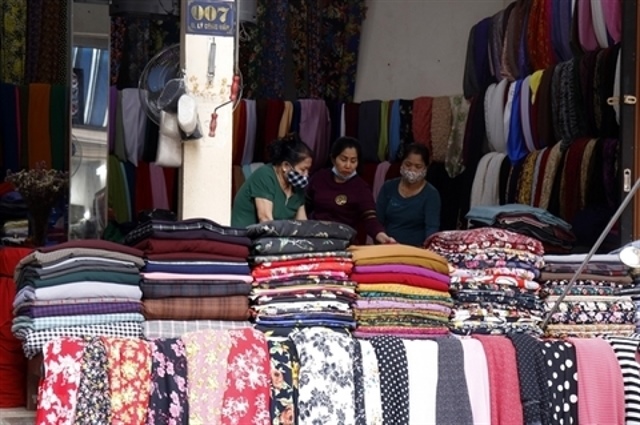Surging exports help lift local currency value
Surging exports help lift local currency value
As exports in the first 10 months of this year surged to a 3-year high, the Vietnam dong appreciated around 0.9 percent against the US dollar during the period.

In just over 10 months, total export revenue exceeded 2010’s ($93.9 billion compared to $72.2 billion) and is close to the record levels of 2011 ($93.9 billion against $96.9 billion).
If in the remaining two months of this year, the export revenue of each month reaches the rate of October at over $10 billion, the whole year’s export revenue may exceed $ 114.4 billion, according to the government website.
The latest data of the General Department of Customs of Vietnam showed that the trade surplus in October reached $156.4 million, bringing that in January-October to $64.1 million. The corresponding forecast of $500 million and a $357 million trade deficit was released by the General Statistics Office of Vietnam (GSO) late last month.
Thus, the actual performance of local exporters was better than expected, said the government website.
The brightest spot
The export earnings in October exceeded $10 billion, making it one of 3 months to reach the $10 billion threshold in 2012.
Export turnover in the first 10 months of this year increased 18.9 percent compared with the same period last year, higher than the initially planned growth rate of 13 percent and higher than the growth rate of most indicators of other economic sectors.
In 40 major export items, the earnings of eight groups, mostly raw materials and ores, saw a reduction, while the remaining 32 groups witnessed significant rises.
They includes mobile phones and accessories, cameras, camcorders and accessories, computers, electronic products and components, plastic materials, glass and glass products, wires and cables, and vehicles and spare parts.
If export growth last year was mainly achieved due to price increases, and only partially due to increased export volumes, the situation has been reversed so far this year.
Specifically, 21 export items saw their revenues reach over $1 billion, led by textiles ($12.5 billion), cell phones and accessories ($10.1 billion), crude oil ($ 7 billion), computers, electronic products and components ($6.1 billion), footwear ($ 5.8 billion), seafood ($5.1 billion), and machinery, equipment, tools and spare parts ($4.6 billion).
Among 70 foreign markets, Vietnam has the largest trade surplus with 52 countries and territories, led by the US ($12.25 billion), Hong Kong ($2.13 billion), Britain ($1.95 billion), Cambodia ($1.91 billion), Germany ($1.42 billion), the Netherlands ($1.39 billion), United Arab Emirates ($1.39 billion), Spain ($1.25 billion), and Japan ($1.2 billion).
The trade surplus has helped improve the trade balance, current account balance and macroeconomic stability via the exchange rate stability.
With the new export data, the 2012 trade deficit is also far lower than in previous years and may be at its lowest in the last decade.
However, the trade surplus is not entirely due to production efficiency from increased competitiveness, but mostly due to the fact that import growth has lagged behind export growth (6.7 percent vs. 18.9 percent). The imports of the local economic sector have fallen by 7.6 percent due to contracting investment, production and consumption
Positive foreign exchange trend
The positive impact of the current exchange rate is a remarkable success in monetary policy operating since early 2012, said an economist of the State Bank of Vietnam (SBV).
The exchange rate between the Vietnam dong and foreign currencies in general, especially the U.S. dollar, is very stable, economist Nguyen Dac Hung told Thoi Bao Ngan Hang magazine, an SBV publication.
According to the GSO, the US dollar appreciated 6.31 percent, 10.07 percent, 9.68 percent, and 2.2 percent against the Vietnam dong in 2008, 2009, 2010, and 2011, respectively.
But the greenback depreciated around 0.88 percent against the dong in the first 10 months of this year.
Specifically, the greenback appreciated against the dong in the first 5 months, and began to devalue in the subsequent months.
Many forecasts pointed out that with current events, and although the foreign exchange market can be more volatile in the last 2 months of this year, the dong will not depreciate 1.5 percent over the greenback.
“This is a rare phenomenon in the foreign exchange market for many years, precisely from 1993 to present.”
“Aforementioned changes in exchange rates have had a positive impact on the socioeconomic situation.”
“First, exchange rate stability has a positive impact on people's psychology and that of financial markets. This reduces the allure of hoarding greenback as assets, curbing speculation in foreign currency of the local businesses and contributing to less dollarization in the local economy.
“But the most outstanding success is the contribution to the curbing of inflation target in the monetary policy, represented in the stabilization of the consumer price index.”
“In particular, Vietnam has long suffered from a large-scale trade deficit.”
Therefore, the exchange rate fluctuations, or the devaluation of the dong, have led to the stance of "imported inflation" in the country's economy over the past several years.
A stable exchange rate also impacts exports and helps reduce the constant trade deficit, which in turn helps stabilize the forex rate.
It also has a positive impact on the external public debt of Vietnam.
tuoitrenews

























